3rd Party Showcase (3PS) Archive: Articles 1 to 10
3rd Party Showcase #1
Rayman: Raving Rabbids (Wii)
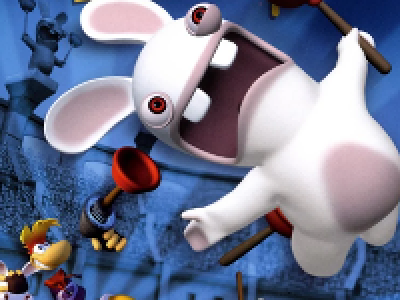
| System | Wii |
|---|---|
| Developer | Ubisoft Montpellier |
| Publisher | Ubisoft |
So, maybe you're disappointed that WarioWare: Smooth Moves has been delayed in the U.S. until 2007. Perhaps it has influenced your decision as to whether you should pick up a Wii right away, or wait. After all, how will you quench your thirst for mini-game after mini-game that force you to use the motion sensitive remote in fun and unusual ways? Well, Ubisoft has mixed a drink for you. Rayman Raving Rabbids may not be the platform game it started out to be (or that the series originated as), but it will more than fill the Wario gap with its own mini-game extravaganza.
A story mode has you controlling Rayman through the various challenges that are gradually presented to you in a level-like fashion, and each challenge can be accessed again at any time in the replay mode. There are over 70 mini-games included in the package, and all have been created specifically to take advantage of the Wii Remote and Nunchuck. Some have even been deliberately designed to be physically demanding. Pumping carrot juice, swinging cows around your head, or simply running from point A to point B will likely tire your arms after only a couple of minutes. But that's still a lot longer than the three-to-five second twitch experiences that WarioWare offers.
The graphics are also notable, being sharp, colorful and gorgeous. It goes to show that high technology doesnt replace great style and art direction. Coming from designer Michel Ancel and his team at Ubisoft, it's no surprise. His previous games, including Beyond Good & Evil (Gamecube) and Rayman 2 (Nintendo 64), presented vibrant worlds with wonderful, dreamy atmospheres. Rayman may be one of the more visually striking games available for the Wii's launch.
So, don't wait for WarioWare. Pour yourself a cool, refreshing glass of Rayman Raving Rabbids. It's available at launch, and it's a great showcase for your brand new Wii.
Posted by Nester on 19 November 2006
Third Party Showcase #2
Trauma Center: Under the Knife (Nintendo DS)
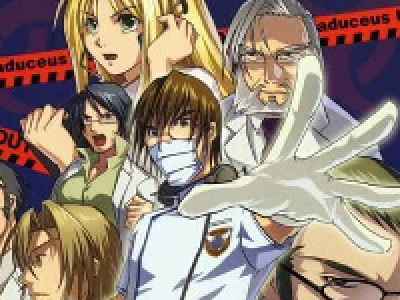
| System | Nintendo DS |
|---|---|
| Developer | Atlus |
| Publisher | Atlus |
Do you suffer from boredom and lethargy? Do you have twitchy thumbs and sore wrists? Does the thought of playing another derivative video game sound about as exciting as passing a kidney stone? These are the symptoms of JGS (Jaded Gamer Syndrome), and it's a serious condition. Fortunately, noted physician Derek Stiles, PhD., has devised a cure. He recommends you get a healthy dose of Trauma Center: Under the Knife on the DS.
Traditionally, Nintendo has always made the most of its own technology, so it was a bit of a surprise that one of the earliest, most creative, and best uses of the DS's interface came from Atlus. Trauma Center puts you in the position of a surgeon who must perform various operations. Don't let the idea scare you off. This is not a simulation.
The clever interface puts your nurse (and other characters) on the top screen where they guide you through each procedure and give you advice. The actual operating happens on the touch screen and, as you can imagine, it's a truly hands-on experience. Success will depend on speed, dexterity, and memorization. A steady hand goes a long way in the OR.
The gameplay has often been likened to a puzzle game, or a digital version of the board game, "Operation". However, I think that's a misnomer. Trauma Center isn't so easily categorized, and trying to wedge it into one only undermines its unique experience.
Trauma Center has also been remade for the Wii as Trauma Center: Second Opinion, and it takes advantage of the Wii's interface just as Under the Knife did the DS's. It also adds some extra features. However, a detailed diagnosis shall be saved for another showcase.
If you have a DS, Trauma Center is an essential. Pick it up, stat, and make sure you don't become a victim of JGS.
Warning: Contents may be addictive. Do not use while driving or operating heavy machinery. Side effects include excitability, cold sweats, and drawing fan art of nurse Angie. If your Wii stays erect for more than 4 hours, see your doctor.
Posted by Nester on 26 November 2006
Third Party Showcase #3
Gunstar Heroes (Virtual Console)
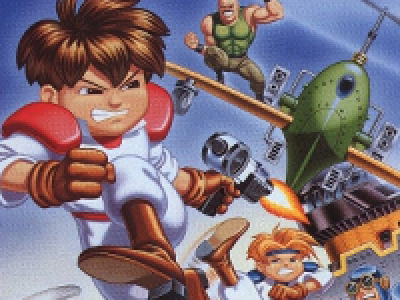
| System | Wii Virtual Console (Mega Drive) |
|---|---|
| Developer | Treasure |
| Publisher | Sega |
Perhaps a better name for the independent Japanese developer Treasure would be "Hidden Treasure", as that's what most of its games end up becoming. Despite working with some of the largest publishers in the business, including Nintendo, Sega and Capcom, none of their games have ever really hit the mainstream. These include Mischief Makers (Nintendo 64), Ikaruga (Gamecube), and Nintendo's own Wario World (Gamecube). Not to mention their very first game, and one of their best, Gunstar Heroes.
Known for taking a basic gameplay mechanic and utilizing it in as many ways as possible, Treasure gave the treatment to the run-and-gun genre with Gunstar Heroes. Separating it from its precursors, most notably the Contra series, are colorful, anime style graphics, and the lack of one-hit kills. In this game, you get one life with a set amount of HP that can be refilled with life restoring items, even past its initial value. Fall into a bottomless pit? No problem! After an HP deduction, you get thrown right back into the action where you belong!
And speaking of action, GH provides tons of it. There's also plenty of variety. One level has you on a high-speed mine cart. In another, you're flying a nifty little spaceship. Or you just might end up rolling a die for a Mario Party-style board game level. The creativity and quirkiness that went into this game are refreshing even today.
Another thing GH provides is one of the best 2-player co-op experiences you can have in a classic game. The two players can interact, even grabbing and throwing each other without causing damage, but still bowling over any bad guys unfortunate enough to be in the way.
While not known for exploiting franchises, Treasure finally created a sequel for the Game Boy Advance in 2005 called Gunstar Super Heroes. It offered even more action, variety and quirkiness. But despite critical praise, it was a commercial flop, making it yet another "Hidden Treasure".
Still, thanks to the Wii's Virtual Console, you can easily dig up the original blast-a-thon from the comfort of your own home. It's a great time to go Treasure hunting!
Posted by Nester on 3 December 2006
Third Party Showcase #4
Phoenix Wright: Ace Attorney (Nintendo DS)
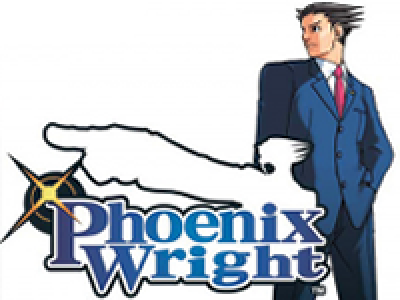
| System | Nintendo DS |
|---|---|
| Developer | Capcom |
| Publisher | Capcom |
Let's say you're out in public. Maybe you're in a restaurant or waiting for a bus. You decide to whip out your DS to pass the time. At length, some curious soul nearby notices you.
"Is that one of those iPod things?" you're asked.
"No," you reply, "It's a Nintendo DS. You play video games on it."
Pursuing casual curiosity, this person goes on ask what sort of game you're playing. If you say your playing a shoot-em-up or some other typical genre, your inquisitor will likely lose interest. But if you say that you're playing a lawyer game, then get ready for further questioning!
Phoenix Wright: Ace Attorney is really no more a law simulation than Trauma Center is a medical sim. You spend your time examining testimonials, providing evidence and spotting contradictions in your efforts to reveal the truth. Additionally, you also do your own investigating at various crime scenes, dusting for fingerprints and uncovering clues. It's clearly not an exciting game.
OBJECTION! The over-the-top presentation gives the game a lot more energy than you might think, and the overwhelming odds against you provide a lot of motivation to succeed. It may not have much action, but the experience is very engaging. The game's personality is the key.
Despite being developed and published by completely different companies, Phoenix Wright and Trauma Center are almost like companion games. They each take a subject that doesn't initially sound like the basis of a fun video game, and then create very compelling and unique gaming experiences. Judge for yourself. This is the kind of creativity the DS was intended for.
Phoenix Wright is a remake of a Game Boy Advance game that was released only in Japan. The GBA series has already seen three installments over there, with a fourth in development specifically for the DS. As with the original game, the sequel has also been remade for the DS, and it's scheduled for international release next year.
The evidence is clear. Capcom has created a unique, compelling and fun game for the DS that relies on logic and reasoning more than dexterity. If new gaming experiences are the reason you own a DS, then Phoenix Wright: Ace Attorney belongs in your game library. I rest my case.
Posted by Nester on 10 December 2006
Third Party Showcase #5
Castlevania: Portrait of Ruin (Nintendo DS)
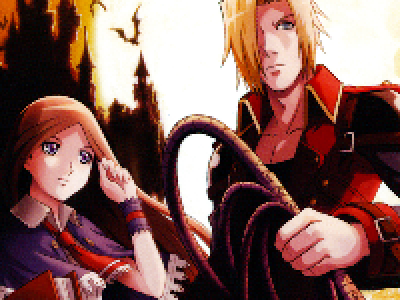
| System | Nintendo DS |
|---|---|
| Developer | Konami |
| Publisher | Konami |
It was 20 years ago on a dark and stormy night. The moon was full, the wind was cold, and Konami released the original Castlevania on the NES. To this very day, the series has continually revived over multiple platforms, haunting gamers year after year. In recent times, the best installments of the series have seen light on the Game Boy Advance and Nintendo DS. This tradition continues with Castlevania: Portrait of Ruin.
Ever since the release of Symphony of the Night on the PlayStation in 1997, many games in the series have followed the Metroid-formula. While Portrait of Ruin doesn't stray too far from this formula, it attempts to freshen it up with a few new twists. Most noticeable is the inclusion of two playable characters on screen at the same time. You can switch between them at will, and they can interact with each other, teaming up for attacks. It's a pretty fun gimmick.
The game map itself has been divided into several areas. Rather than just explore one huge castle (or two), you can transport to other areas (via magic paintings) that have their own map screen. These areas are generally much more linear and serve as a throwback to the classic Castlevania games of yore. Although none of these individual maps are anywhere near as large as the castles in previous games, the overall game is about 50% larger than Dawn of Sorrow.
Portrait of Ruin also offers something that has never, ever appeared in a Castlevania game before. For the first time, two players can team up and take on the unholy minions in a special 2-player co-op mode. It's restricted to a simple Boss Rush type of game, but it's compatible over both LAN and Nintendo Wi-fi Connection. Your friend can hold the stake while you drive it in, and you don't even have to be on the same continent!
So, as the wolves howl against a large, full moon, and the children of the night seek fresh prey in the unsettling darkness, keep your dual screens brightly lit. The tried and true gameplay, new features, and multi-player mode make yet another handheld Castlevania worth braving the horrors for. Whether you're a newcomer to the series or a long time fan, Castlevania: Portrait of Ruin is a frighteningly good game for the DS.
And, unlike Dracula, it doesn't suck.
Posted by Nester on 17 December 2006
Third Party Showcase #6
Bonk's Adventure (Virtual Console)
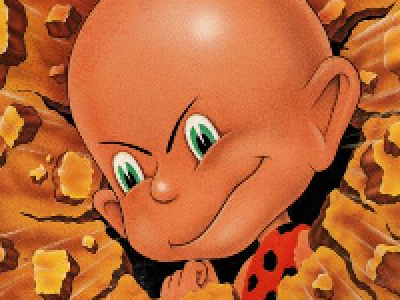
| System | Wii Virtual Console (TurboGrafx-16) |
|---|---|
| Developer | Hudson Soft, Red, Atlus |
| Publisher | Hudson Soft |
Nintendo's New Super Mario Bros. for the DS was a reminder of why platform games were so popular during the 8- and 16-bit eras. It wasn't about collecting stuff or fetching keys. You didn't spend time talking to other characters or watching cutscenes. And there certainly wasn't any official way to get 100% completion. It was just pure platforming, running and jumping for the sake of getting to the end of the level. Maybe you bopped some bad guys and scored a few bonus points along the way. Sometimes, less is more. Bonk's Adventure, originally released for the TurboGrafx-16, is a wonderful example of this simpler time.
Bonk (or B.C. Kid, as he was known in Europe) is a comical little caveman with a massive cranium, and he served as the mascot for the TG-16. He literally uses his head to attack enemies, pound the ground, and coast through the air. Pack some aspirin because you'll be bashing prehistoric enemies for six levels and a handful of bonus stages.
Story? Save the princess. It's primitive, but hey, it's 10,000 B.C.
Even though he never gained the popularity of heavy hitters like Mario or Sonic, Bonk's legacy continued with multiple sequels across multiple platforms. Two more games followed on the TG-16, and his futuristic descendant, Zonk starred in his own spin-off game, Air Zonk. Bonk also made appearances on the original Game Boy, NES and Super NES. His first adventure was remade and released on the Gamecube and PlayStation 2 in Japan in 2003.
If you love New Super Mario Bros. or classic platform games in general, Bonk's Adventure is one to look into. Now you can enjoy the original version of Bonk's classic adventure, and you don't even have to dig up a fossilized TG-16 to do it. Thanks to the Virtual Console, all you need is a Wii to bonk stuff. (I may want to rephrase that.)
Posted by Nester on 24 December 2006
Third Party Showcase #7
Super Monkey Ball: Banana Blitz (Wii)
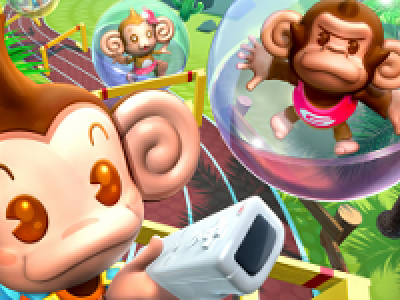
| System | Wii |
|---|---|
| Developer | Sega |
| Publisher | Sega |
One of the more notable launch titles for the Gamecube was the original Super Monkey Ball. Based on an arcade game, the object was to roll a ball with a monkey in it through an obstacle course in order to reach the goal. This was accomplished by tilting the entire playfield, causing the monkey ball to roll downhill. It's a simple concept, but mastering the more advanced courses was as difficult as trying to avoid dirty puns in this write-up. The series has gone on to have several sequels and spin-offs across multiple systems, but the monkey ball has rolled full circle with the Wii launch title Super Monkey Ball: Banana Blitz.
The original controls were as simple as tilting the control stick. It couldn't be simpler. Actually, it could. With the Wii remote, just tilt the whole controller in any direction and the playfield corresponds. It's so simple, even a monkey can do it. However, the developers have also introduced a couple of new gameplay wrinkles. Now you can make your monkey ball jump with a tap of the A button, and you also have to take on some boss battles.
There is a larger emphasis on the multi-player mini-games. 50 of these are included. Some are better than others, and a few are barely worth playing at all. None-the-less, you're sure to find at least a few that you and your banana blitzing buddies will keep coming back to.
The studio that developed most of the games in the series used to be known as Amusement Vision. This was the same team responsible for F-Zero GX on the Gamecube (and the AX arcade version), as well as the Sega classic Daytona USA. They know their racing games, but put a few monkeys in balls, and they go bananas!
This new edition of Super Monkey Ball is yet another great showcase for the Wii, and a very natural use of the remote interface. Featuring both a solid single player experience and a variety of multi-player options, it works as either a party game, or just a good time minding your own monkey business. With this game, you're guaranteed to have a ball!
Posted by Nester on 31 December 2006
Third Party Showcase #8
Mega Man ZX (Nintendo DS)
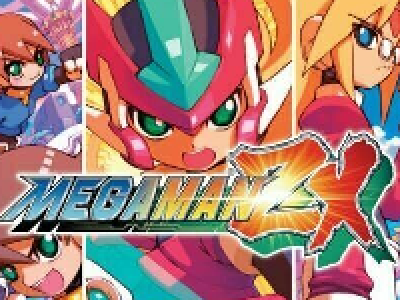
| System | Nintendo DS |
|---|---|
| Developer | Capcom |
| Publisher | Capcom |
Those mega busy bees over at Capcom have certainly been mega prolific when it comes to producing Mega Man games. The series is reaching its 20th anniversary in 2007, and there are around 50 unique releases in the franchise. Sequels, spin-offs, remakes, compilations and reinventions galore make for a very impressive games-to-year ratio. "Market saturation" has no meaning to Capcom. Mega Man ZX is the latest incarnation of the mega franchise.
While Mega Man has diverged into adventures, RPGs and sports over the years, ZX continues the side scrolling tradition of the series' roots. Story wise, it's a sequel to the Mega Man Zero series, which, in turn, was a sequel to the Mega Man X series. But despite its traditional action-platform gameplay, ZX still manages to have a few new tricks up its mega sleeve. Following in the footsteps of Metroid and Castlevania, ZX takes more of an explorative approach, allowing you to wander around one large game world rather than separate levels. Capturing extra abilities from boss robots in classic Mega fashion allows access to new areas. And as in the previous examples, it makes for a compelling experience.
Despite that the game all but ignores the unique features of the DS, and that most of the vocal work is still in Japanese, the presentation is still pretty slick. There are several animated sequences peppered throughout the game, and the graphics are as clean and sharp as classic 16-bit Capcom games. Mega cool!
In true Capcom fashion, there is sure to be a mega load of mega sequels, and hopefully we'll see this new series evolve. But this is where it begins, and it's off to a mega start. If you're a fan of Mega Man, Mega Man X, Mega Man Zero, or action-platform games in general, then power up your Mega Buster and check out Mega Man ZX.
Posted by Nester on 7 January 2007
Third Party Showcase #9
Dragon Quest Heroes: Rocket Slime (Nintendo DS)
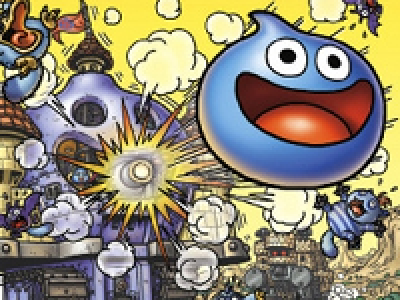
| System | Nintendo DS |
|---|---|
| Developer | Tose |
| Publisher | Square Enix |
The most recognized enemy in the Dragon Quest series is actually not the dragon. Instead, it's the small, blue, sticky, "have-a-nice-day" smiley-faced glob of goo called a Slime. They have about 2 HP and run away at the first sign of trouble; but every dog has its day, and every Slime has its time. In Dragon Quest Heroes: Rocket Slime, a spin-off of the classic RPG series, a particularly squishy Slime named Rocket is given his chance to shine.
The original Dragon Quest (or Dragon Warrior, as it was renamed in North America) was the grandfather of all console RPGs and set the standard for decades to come. However, Rocket Slime does not slither in its grandfather's trail. It's more of an adventure game in the style of the Zelda series, particularly in its dungeon exploring aspects. Rocket's abilities, however, are much more unique. For instance, he can slingshot himself around to attack enemies and reach items.
Another unique aspect of the game is the tank battles. Rocket acquires a big, Slime-shaped tank, which he will eventually be able to outfit with a crew. The battles themselves are decidedly strategic and, like Rocket, flexible. A multiplayer mode accommodates you and up to three of your gelatinous friends, however each of you must have your own copy of the game, and online play is not available.
Rocket Slime is actually the sequel to a previous Dragon Quest Heroes game that was only released in Japan. This version has a very charming English translation featuring references to other games in the Square and Enix pools, not to mention a lot of slippery puns. The game oozes with humor.
The quest, tank battles, and story gel together nicely. The presentation may seem a little on the young side, but this game is definitely ready for prime slime. If you're looking for a good adventure for gaming on the goo, Dragon Quest Heroes: Rocket Slime will be very absorbing. Forget the dragon, go on a Slime Quest.
Posted by Nester on 14 January 2007
Third Party Showcase #10
Metal Slug Anthology (Wii)
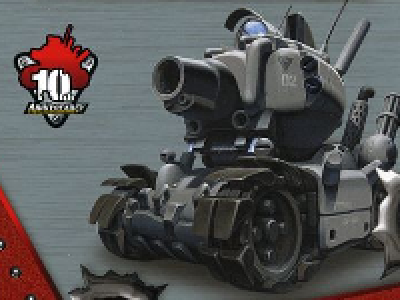
| System | Wii |
|---|---|
| Developer | Terminal Reality |
| Publisher | SNK Playmore (US/Japan), Ignition (Europe) |
Atten-SHUN! Listen up, soldier! Do you think you have what it takes to survive the relentless, gut-wrenching, heart-pounding onslaught of Metal Slug Anthology? Well, you DON'T! You're not hard-core! You're just a pathetic, soft, gutless, spoon-fed LOSER! You make me sick! You're not fit to wear that uniform! But maybe, just maybe, I might be able to toughen you up. Let's start with a history lesson.
The first Metal Slug was released into arcades in 1996. It was a run-and-gun in the mold of Contra and Gunstar Heroes. It was known for its detailed graphics, smooth animation, and goofy sense of humor. Six more arcade sequels were released over the next 10 years, including a remix of Metal Slug 2 called Metal Slug X. Metal Slug 6 was released into Japanese arcades at the beginning of 2006. All seven original arcade games are included in the Anthology, and it marks the first international appearance of Metal Slug 6.
Now, let's talk control options. There are six different configurations to choose from, and five use the remote and/or nunchuck. Do you know how to hold one of these, kid? Some of the control schemes use the motion-sensor in gimmicky ways, but a couple of them are plenty adequate. You also have the option to use a Gamecube controller, but for some odd reason you can't use the digital pad for movement. However, the analogue stick works surprisingly well, and the rest of the buttons are fully configurable. The most puzzling aspect is the total lack of Classic Controller support. When I find out who's responsible for that, my boot's gonna have a private meeting with his... nevermind.
Oh, you think that's funny? I'll show you funny! The presentation in every Metal Slug game is very comical. Even the basic foot soldiers will laugh at you when you die, then scream like little girls when they see you re-spawn. There are also a few pop-culture references you may notice. A lot of care and detail went into the graphics and animation.
So, you think you're ready for this, soldier? Do you? DO YOU?! Get down and give me 20!!! These games are for action and arcade fans. Some control schemes work better than others, but you'll likely find one that works for you. With seven games in one package, you're getting quite a deal. I doubt the enemy will be so generous. There just might be hope for you yet, soldier. Dismissed.
Posted by Nester on 21 January 2007